Editor’s Key Takeaways: Quick Ways to Convert RAW to JPEG
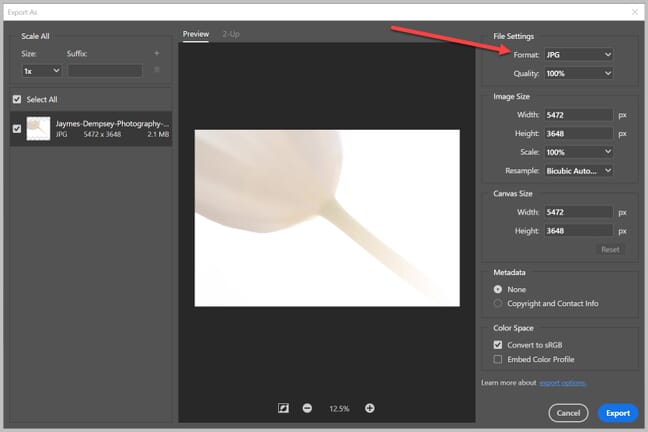
This blog post provides detailed, step-by-step guides on how to convert RAW files to JPEGs using various methods and tools, tailored to both Mac and Windows users as well as those who prefer using online or paid software options.
Here are the main conversion methods covered:
- Mac: Uses Apple’s Preview program; simply open the RAW image, choose Export from the File menu, select JPEG as the format, and save.
- Windows: Recommends the free Pixillion program, guiding users through opening the RAW file, selecting output format as JPEG, and converting.
- Online Converters: Mentions two simple online converters for quick and easy conversions.
- Paid Software: Includes instructions for Luminar 4, Luminar AI, Lightroom Classic, and Photoshop, giving a brief overview of how to convert RAW to JPEG within each program.
This comprehensive guide ensures that no matter the user’s operating system or preferred software, they can effectively convert their RAW files to JPEGs.
Introduction
Looking for a quick way to convert RAW to JPEG on a Mac, Windows, using a dedicated program, or online?
We’ve got you covered.
In this article, we’re going to give you several easy, step-by-step processes for taking your RAW photos and turning them into beautiful JPEGs – no matter the type of RAW file you use, and no matter your computer.
Specifically, I’m going to share my favorite ways to:
- Convert a RAW to JPEG on a Mac (using Preview)
- Convert a RAW to JPEG on a Windows (using the free Pixillion program)
- Convert a RAW to JPEG online (with two of the simplest RAW-to-JPEG converters around)
- Convert a RAW to JPEG with paid editing software, such as Luminar, Lightroom, and Photoshop
Let’s dive right in.

How to Convert RAW to JPEG:
How to Convert RAW to JPEG on Mac
Converting RAW files to JPEGs on a Mac takes seconds.
Convert a Single Image
First, identify the RAW image you want to convert.
Open your image in Apple’s Preview program (right-click on the file and select Open With > Preview.)

Then, once the image has appeared, select File>Export.
A dialog box will pop up with the option to pick a new location for your RAW file. Feel free to select any location and even create a new folder – though you can always leave these options alone, and Preview will automatically save the JPEG alongside the original RAW file.
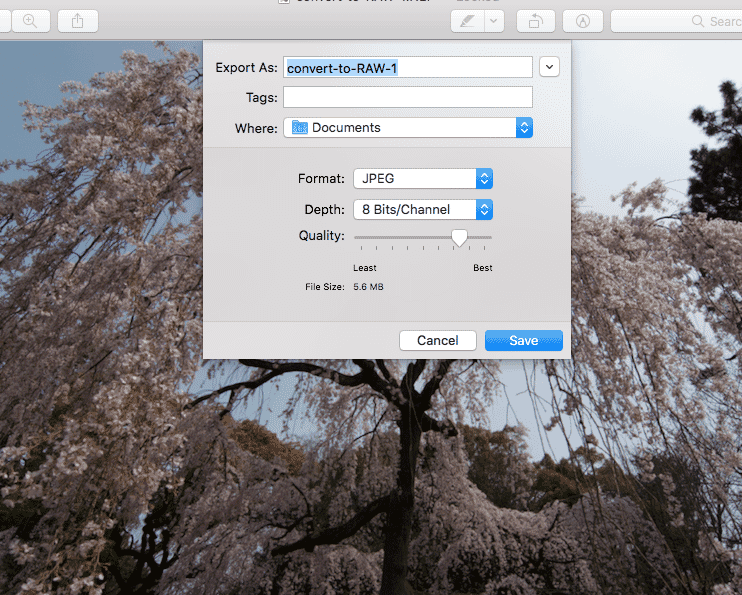
Next, select your preferred Format; here, you’ll need to hit JPEG.
You can leave the Depth on its default (which should be 8 Bits/Channel). If you want an extra-small JPEG, go ahead and drop the Quality slider.
(Personally, I generally export my JPEGs at the highest quality, unless I have a particular reason to crush the file size – e.g., I’m emailing the image or sending it over Messenger.)
Finally, hit Save. And check in your chosen location to see your new JPEG!
Convert a Batch of Images
You can also convert a whole batch of RAW images to JPEGs using Preview.
Simply select all the images, then right-click, hit Open With, and then Preview.
Then tap File>Export Selected Images.
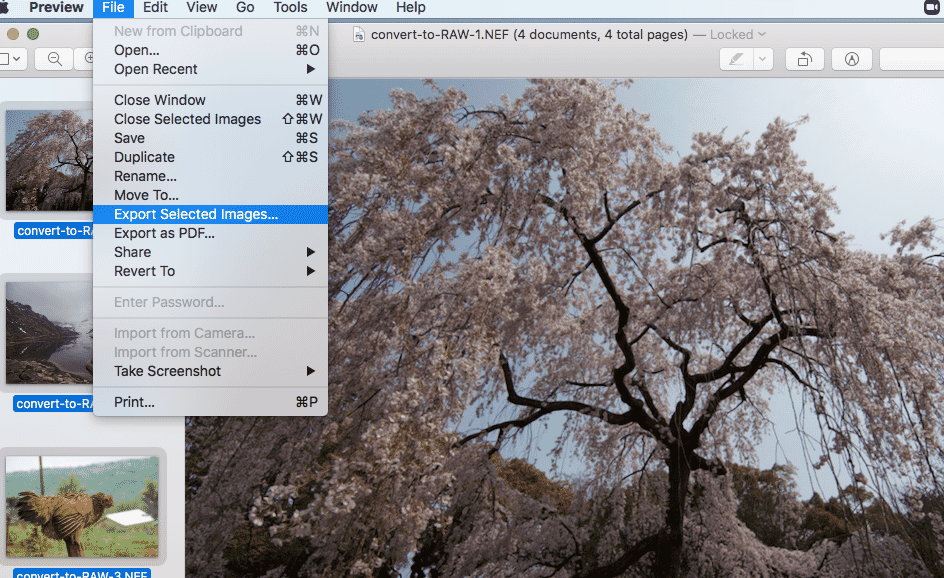
At this point, you’ll need to choose the location where you’d like to save your JPEGs. So pick a folder, then head down to the Options button:
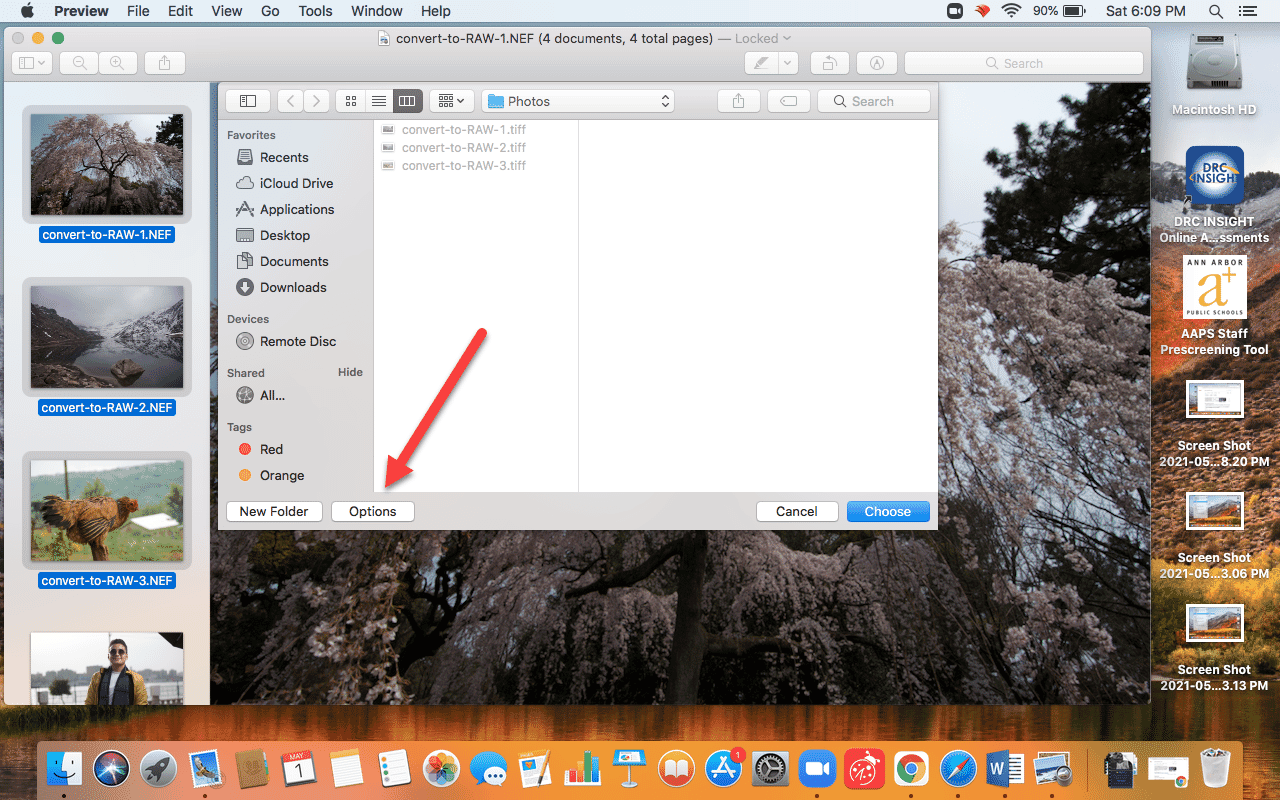
This will bring up your file format and sizing options. Under Format, pick JPEG. Leave the Depth alone, but drop the Quality if you’d like to reduce the file size.
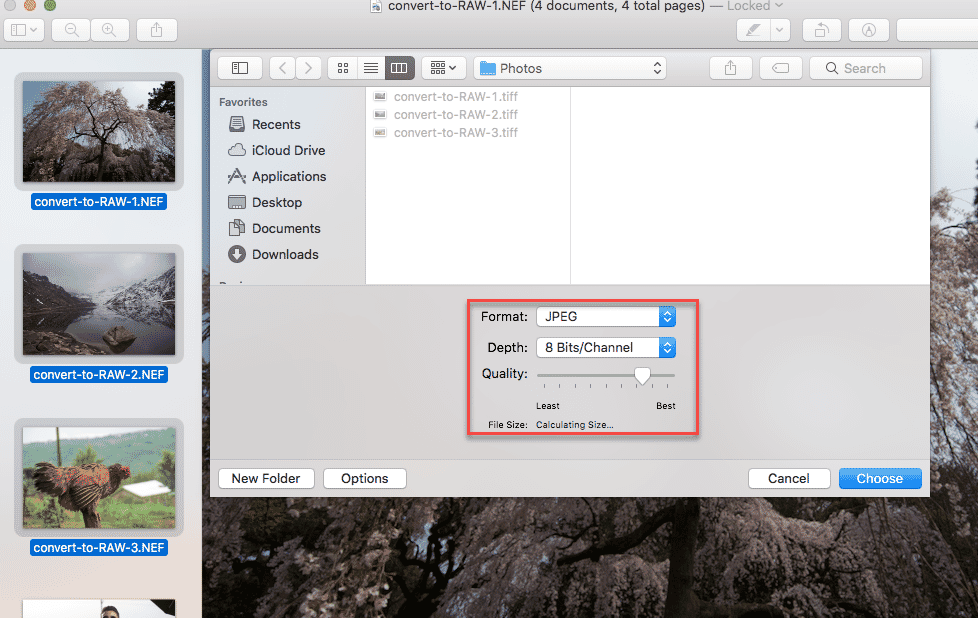
Then, when you’re done, hit Choose.
And that’s it! You’ll have successfully batch-converted your RAWs to JPEGs on a Mac.
How to Convert RAW to JPEG on Windows
Windows computers don’t include an easy RAW to JPEG converter already installed. But don’t worry; there’s a simple desktop program called Pixillion, and it can convert (and batch convert) RAWs to JPEGs with a simple, streamlined process.
First, download Pixillion from the NCH software website:

(Note that you can use Pixillion if your computer has Windows 10, Windows XP, Windows Vista, Windows 7, Windows 8, or Windows 8.1.)
Open the program. You’ll see an “Unlicensed” label across the top, but don’t let it worry you; NCH only requires that you pay if you plan to use the converter commercially.

Next, tap Add File(s):
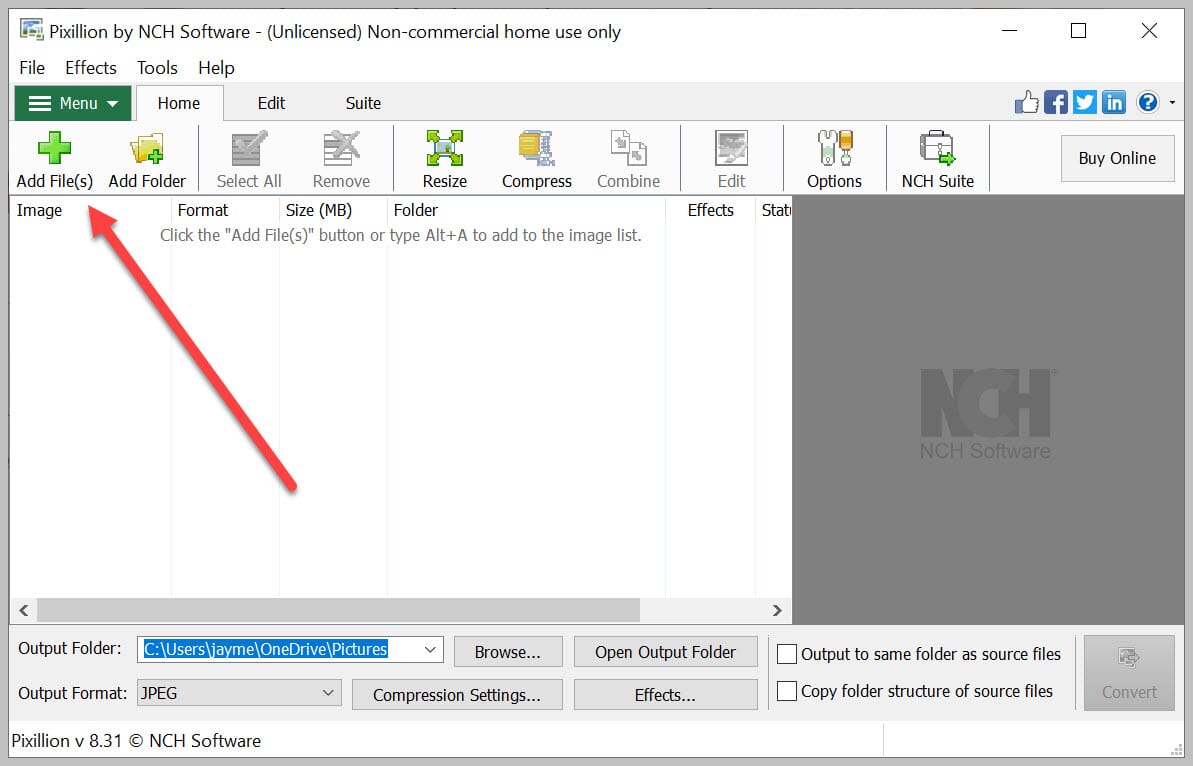
And select the images you’d like to convert.
You can also just drag and drop images onto the Pixillion window.
Once you’ve added the RAWs for conversion, pick your output folder:
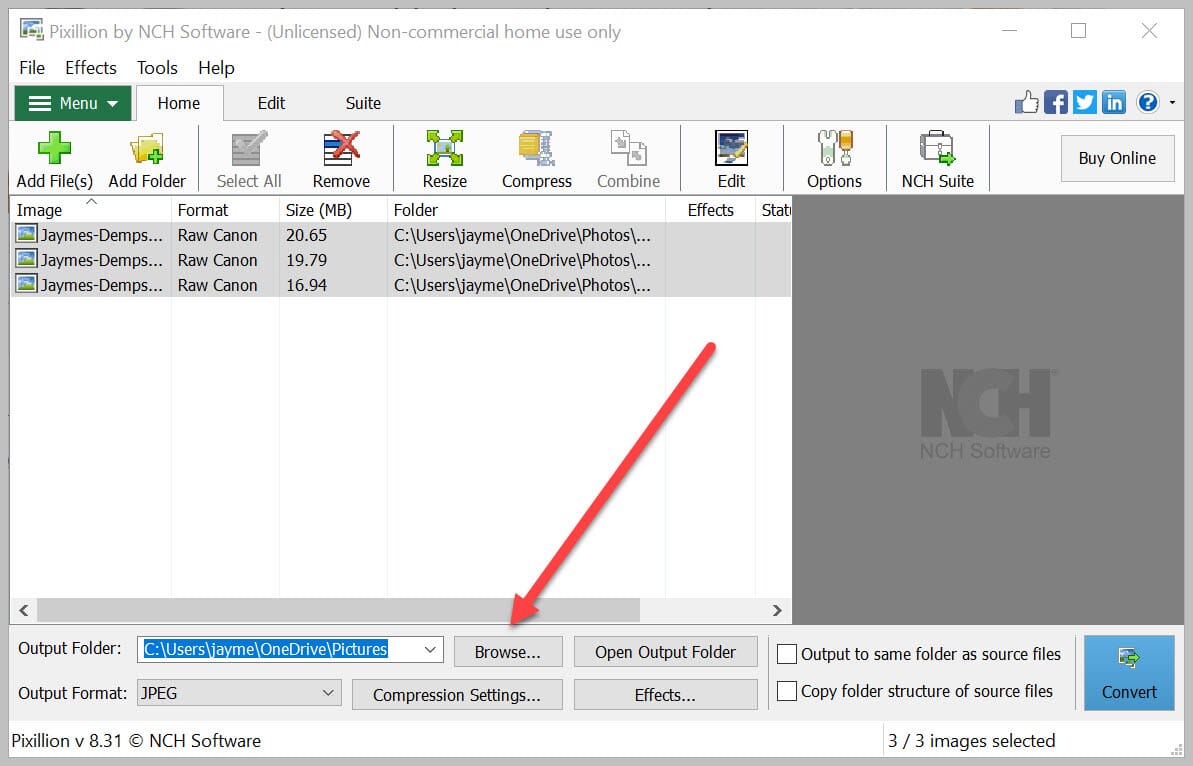
Though you can check the Output to same folder as source files box if you’re looking to save your JPEG to the original RAW file folder:
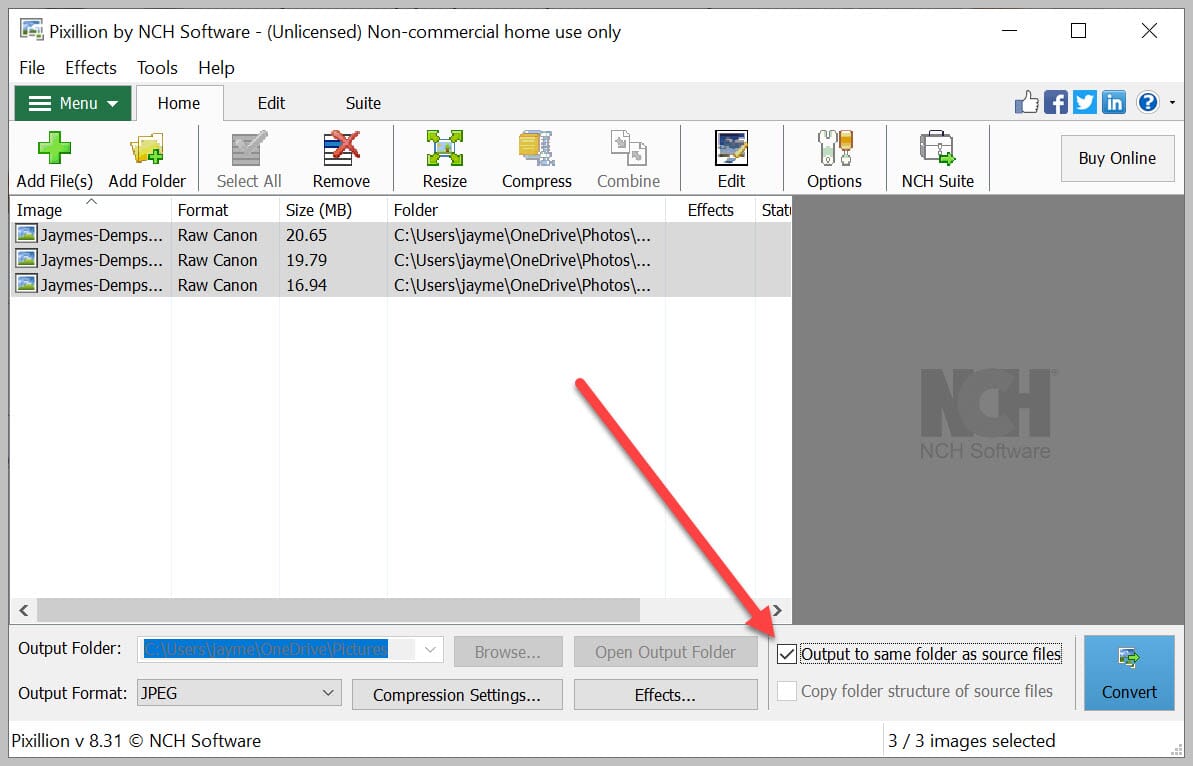
Select the JPEG Output Format:

And if you want to reduce the image size, go ahead and adjust the Compression Settings.
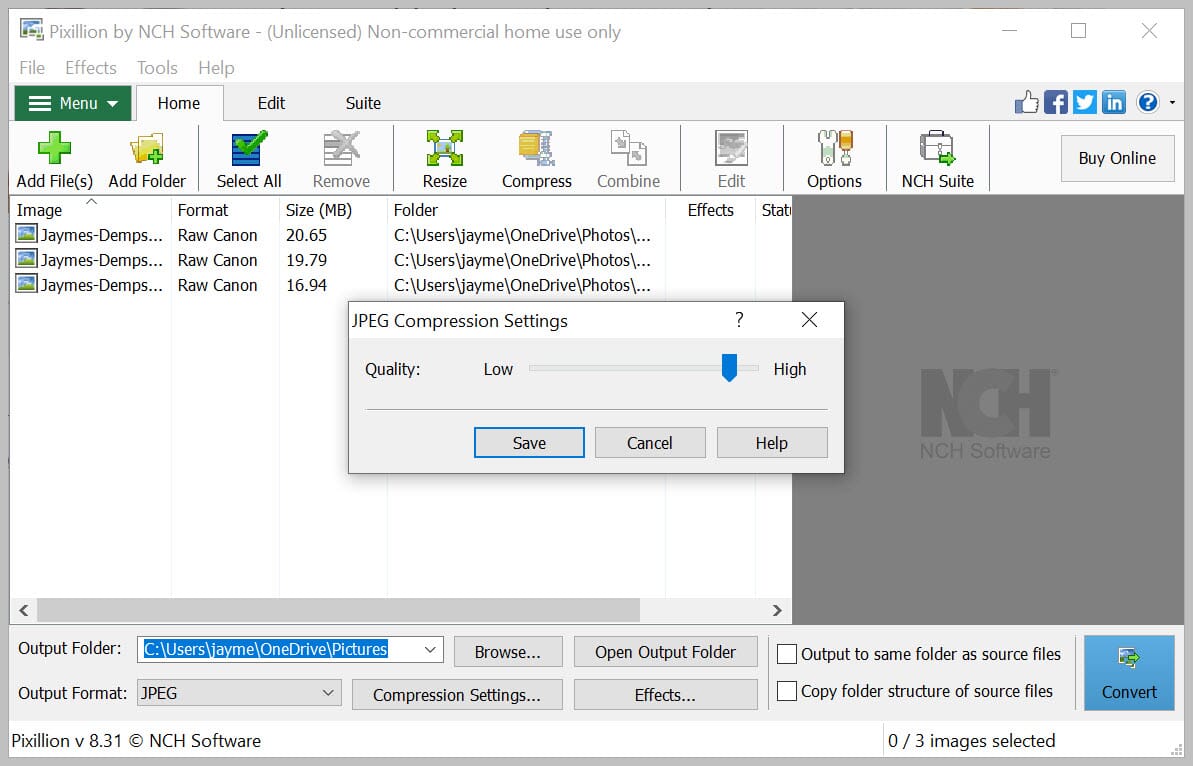
Finally, hit Convert. And your JPEGs will be saved as specified!
How to Convert RAW to JPEG Online
If you’re looking for a quick, no-desktop RAW image converter solution, I highly recommend two online converters:
- CloudConvert
- ILoveIMG
They’re quick, intuitive, and (mostly) free.
Converting with CloudConvert
CloudConvert is a freemium online image converter; the free, no sign-up version allows you to convert up to 25 files per day. After that, however, you’ll need to pay for Conversion Minutes, explained in-depth on the Pricing page.
To convert from RAW to JPEG, simply select your RAW image. Just hit Select File:

Or do a quick drag-and-drop.
Note that you can add multiple files by tapping the Add More Files button (or by simply highlighting several images during the original selection process):

Select JPG from the Convert to dropdown:
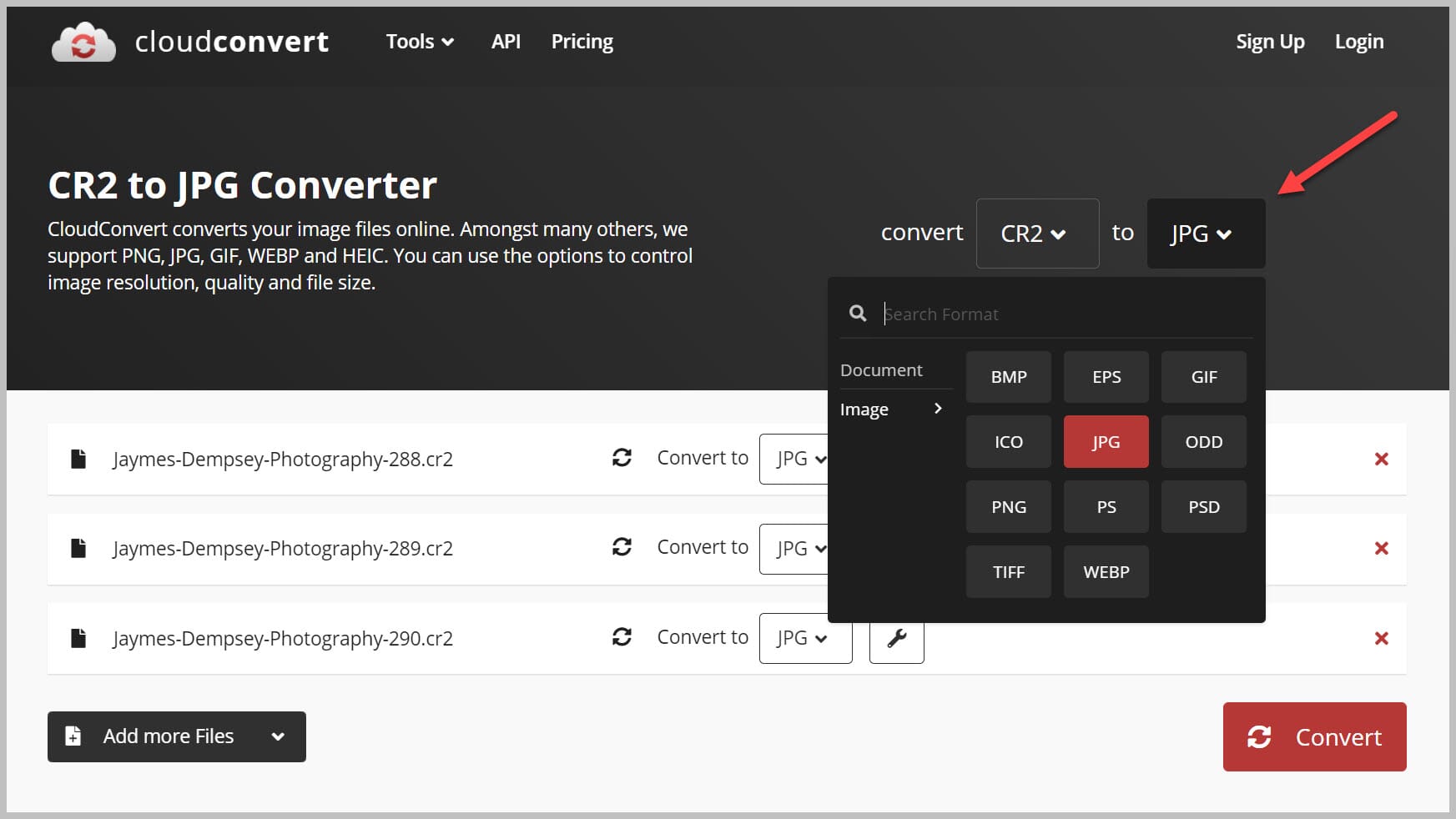
Then open the Tools icon (shaped like a wrench):

Which lets you adjust the image size and quality:
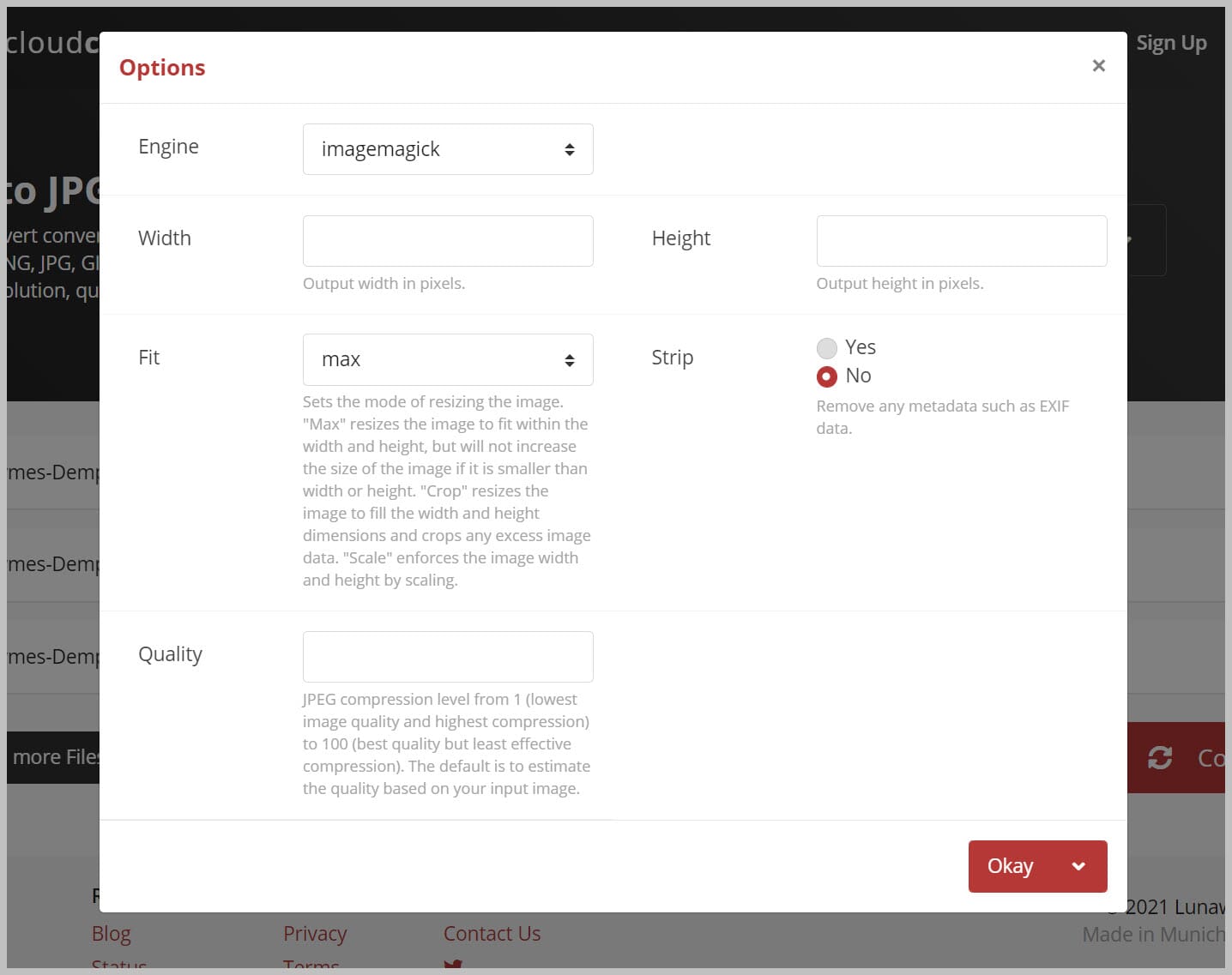
Finally, hit Convert.
Depending on the size (and number) of RAW images, you may have to wait a few minutes. This is a primary drawback of online RAW-to-JPEG converters, by the way – compared to desktop programs, they’re really, really slow.

Once the conversion has finished, you’ll have the option to Download your photos to the desktop:

Or Preview the photos in the browser window:

Converting with ILoveIMG
ILoveIMG is another great online image converter; it even allows for unlimited conversions.
Just head over to the ILoveIMG website, and select Convert to JPG at the top:
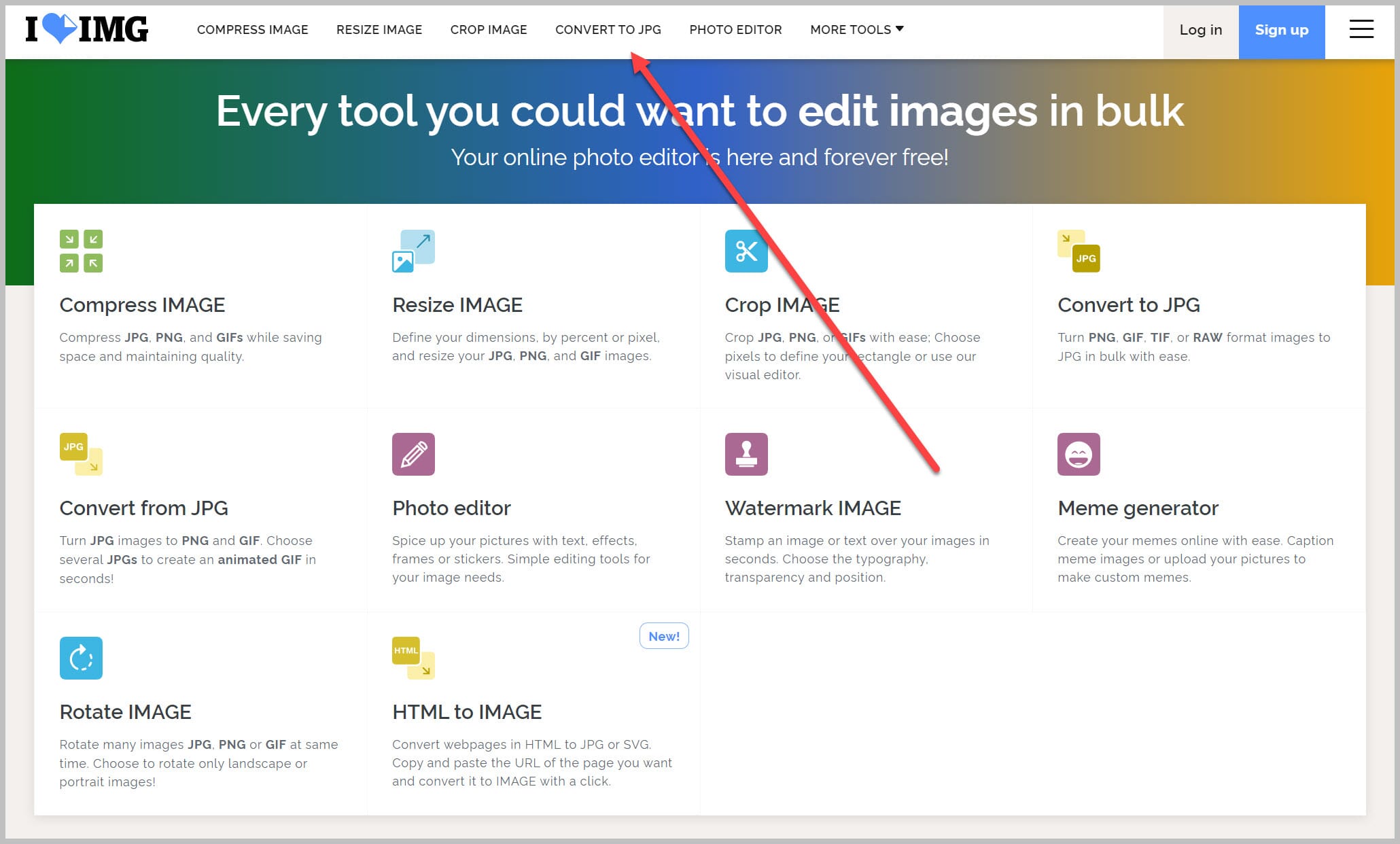
Select your images (or do a drag-and-drop):

You can add additional images with the Add More Images dropdown on the right:
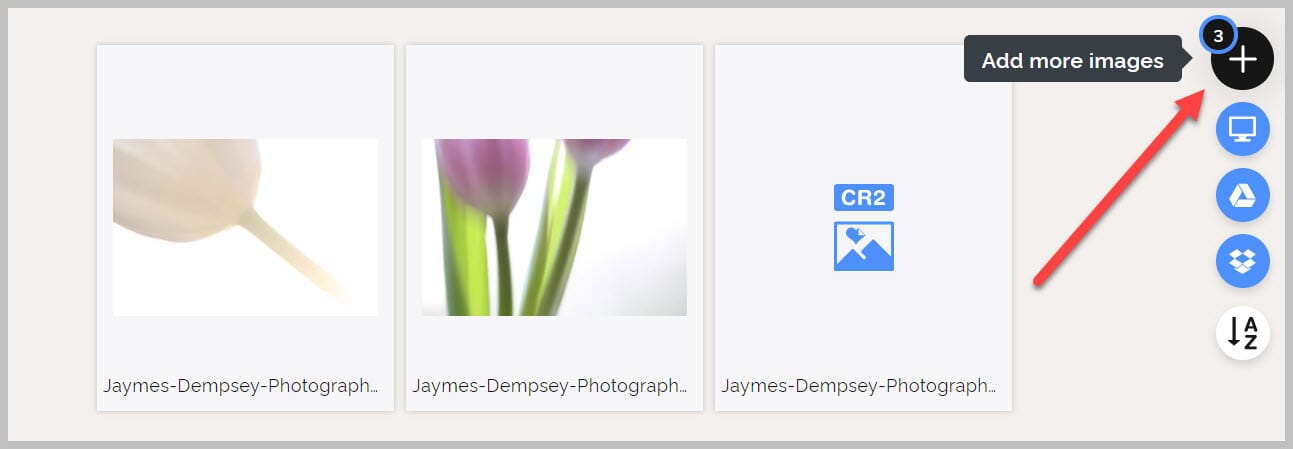
And then, when you’re ready, hit Convert to JPG.
Once the images are converted, you can click to Download your JPEGs:

If you try both CloudConvert and ILoveIMG, you’ll notice that CloudConvert offers more options, but ILoveIMG is faster, plus it’s easier to use (and it offers unlimited conversions). The program you choose depends on your needs, but both will get the job done.
How to Convert RAW to JPEG with Image Editors
Below, I explain how to use Lightroom, Luminar 4, Luminar AI, and Photoshop to convert RAWs to JPEGs.
The advantage to using a dedicated image editor – as opposed to a program such as Preview, Pixillion, or an online converter – is that you can first edit your RAW images, then export them. You also tend to get more conversion options; for instance, Lightroom lets you batch-rename files, adjust the image size, sharpen, and add watermarks, among other things.
How to Convert RAW to JPEG with Lightroom Classic
Start by selecting your RAW image(s) in Lightroom Classic.
(Feel free to extensively edit your shots in Lightroom, first; you might consider adjusting exposure, contrast, colors, and more.)
Head to the Library tab, then click Export:
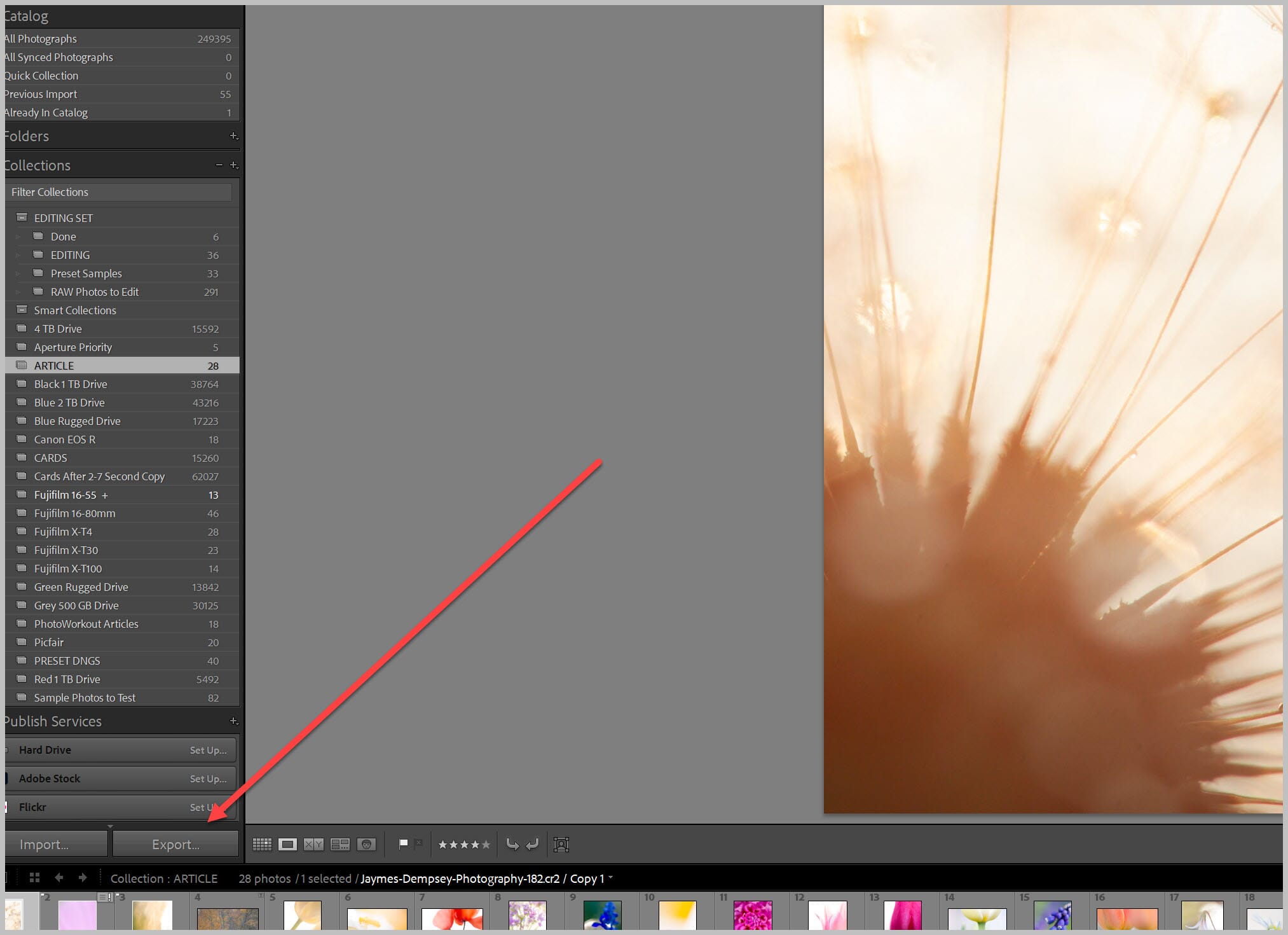
The Export window will pop up, which will tell you the number of files you’ll be converting:
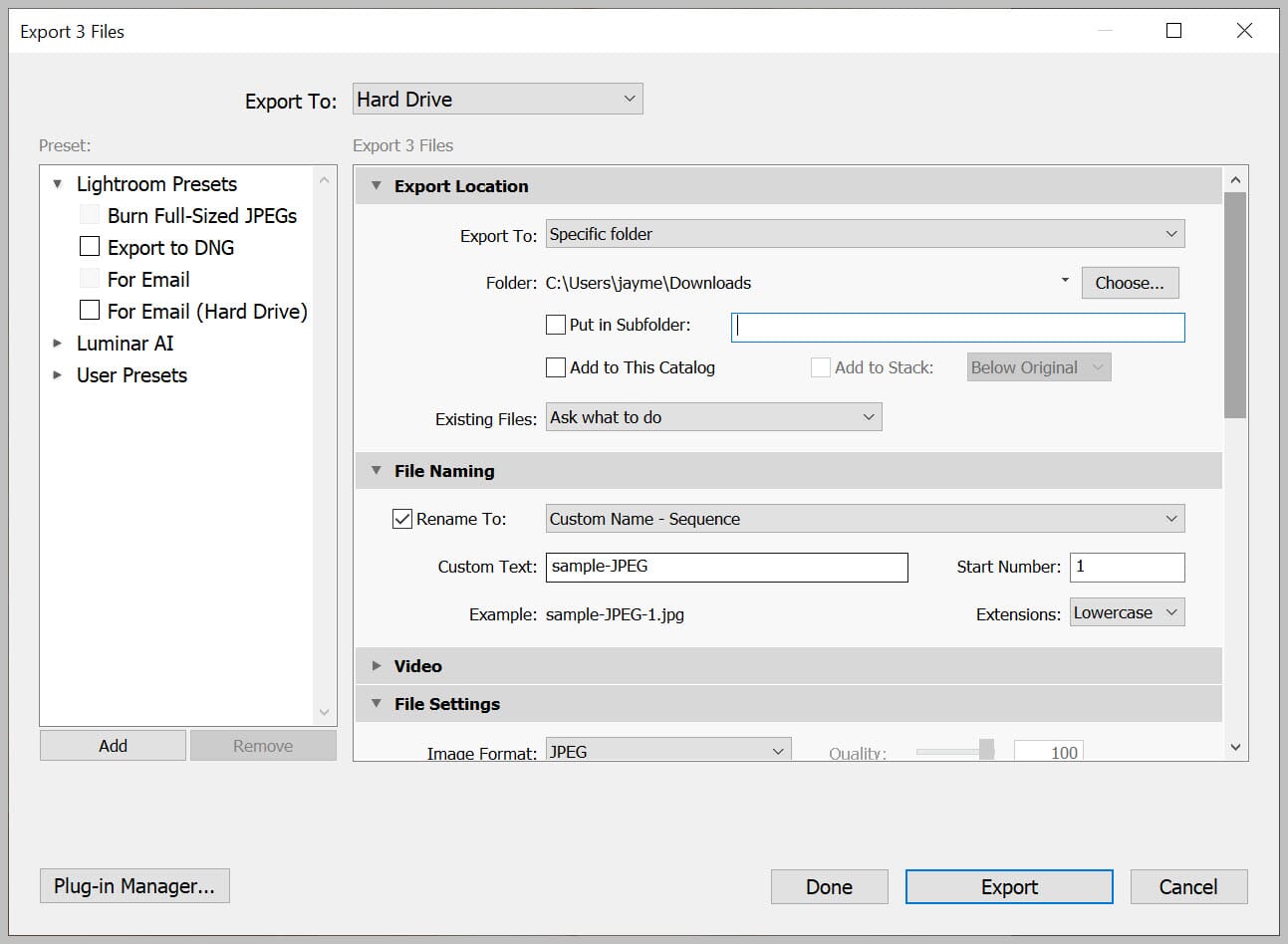
Choose your Export Location:

As well as your file names:

Pick the JPEG file setting and adjust the Quality:
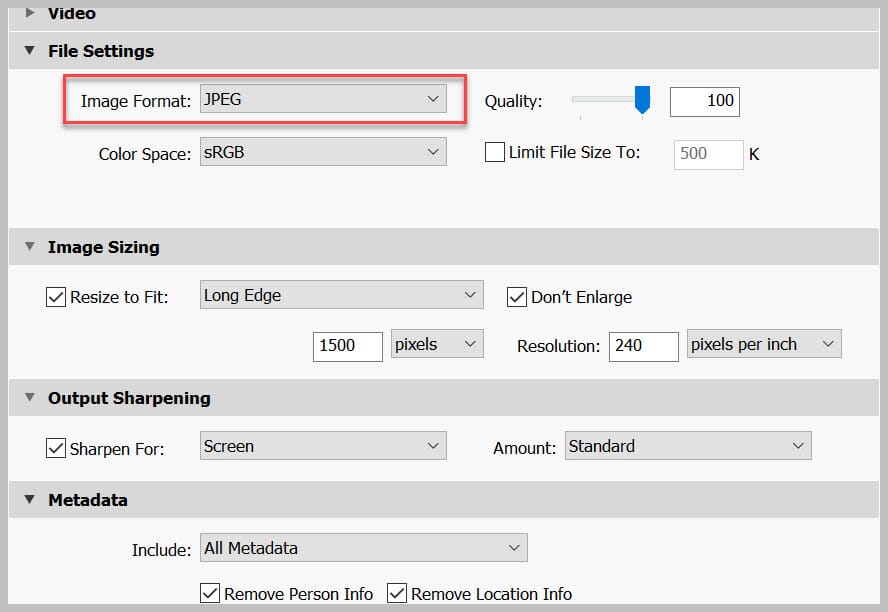
You can also resize images in the Image Sizing panel (I often resize to 1500 pixels on the long end for web display).
Since you’re compressing a RAW to a JPEG, it’s often a good idea to add a bit of sharpening. So check the Sharpen For box and select Screen. You can experiment with different amounts, but Low is a good starting point.

Finally, select Export.
You can watch the Export progress in the upper-left corner of the Lightroom window:
How to Convert RAW to JPEG with Luminar 4
Unlike Lightroom, Luminar 4 doesn’t offer a lot of conversion flexibility. But you can still do simple exports (and batch exports).
For single-image exports, make sure your image is open, then select the Export icon and Export to Image:

Choose your Location and File Name. Then change the Format to JPEG, decide whether to Sharpen (I’d recommend Low sharpening for web display), and do any necessary resizing.
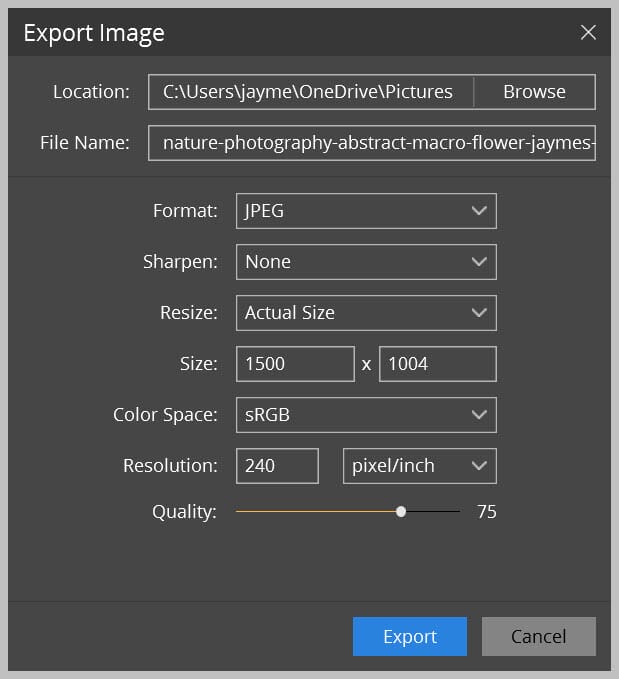
Finally, hit Export.
You can also batch-convert images in Luminar 4, though note that you won’t be able to do any editing first (in other words, you’ll select the images from your desktop, do a conversion, and find the converted copies on your desktop; you won’t have an opportunity to open the images in Luminar to adjust exposure, color, etc).
Here’s how it works:
First, select File>Batch Processing:
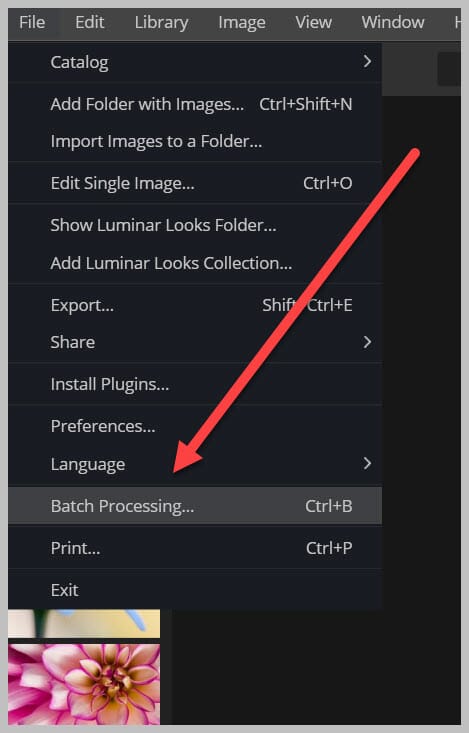
Add the RAW images (you can drag and drop, or you can click the Browse button), then click Continue:
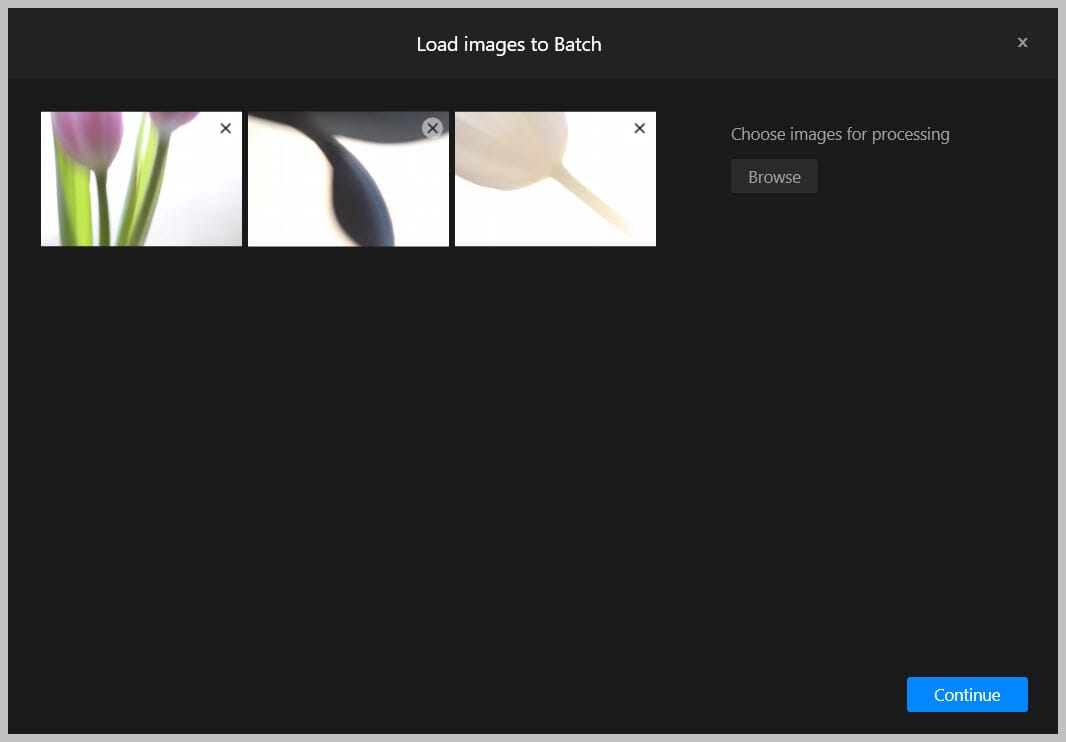
Add a Look via the dropdown menu (if you desire; this is optional), choose a file location, and pick a naming scheme.
Then change the Format to JPEG and adjust the Quality slider if you want to drop the file size:
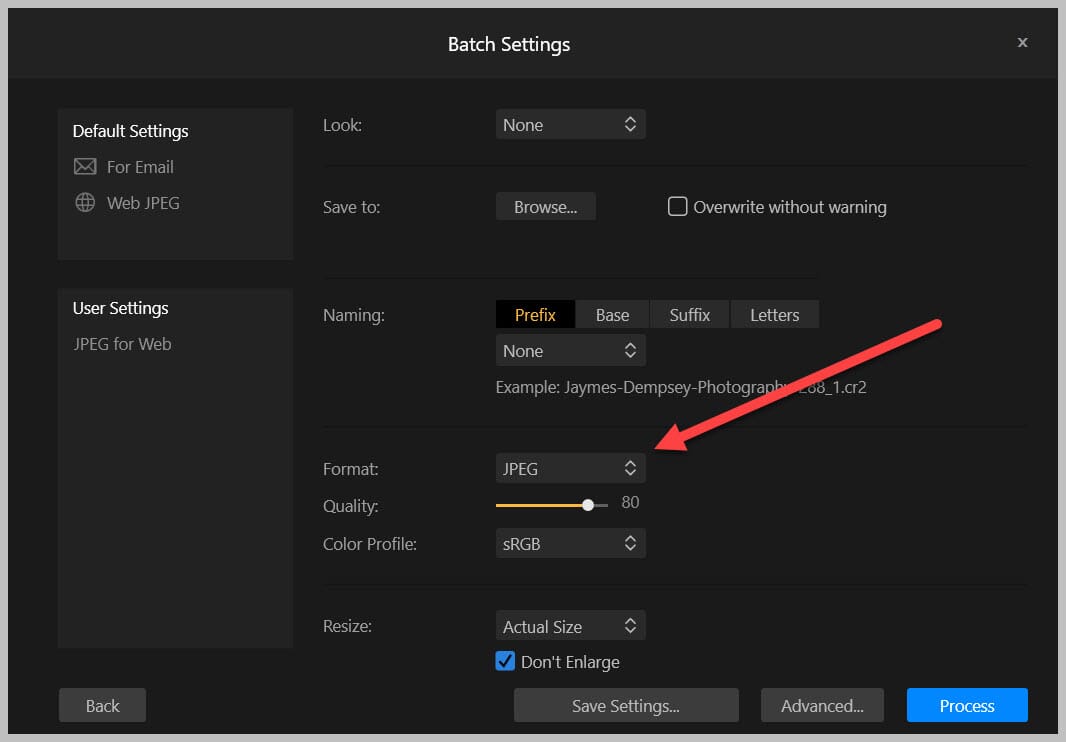
Do any necessary resizing, then – if you want to sharpen your photos – select Advanced:
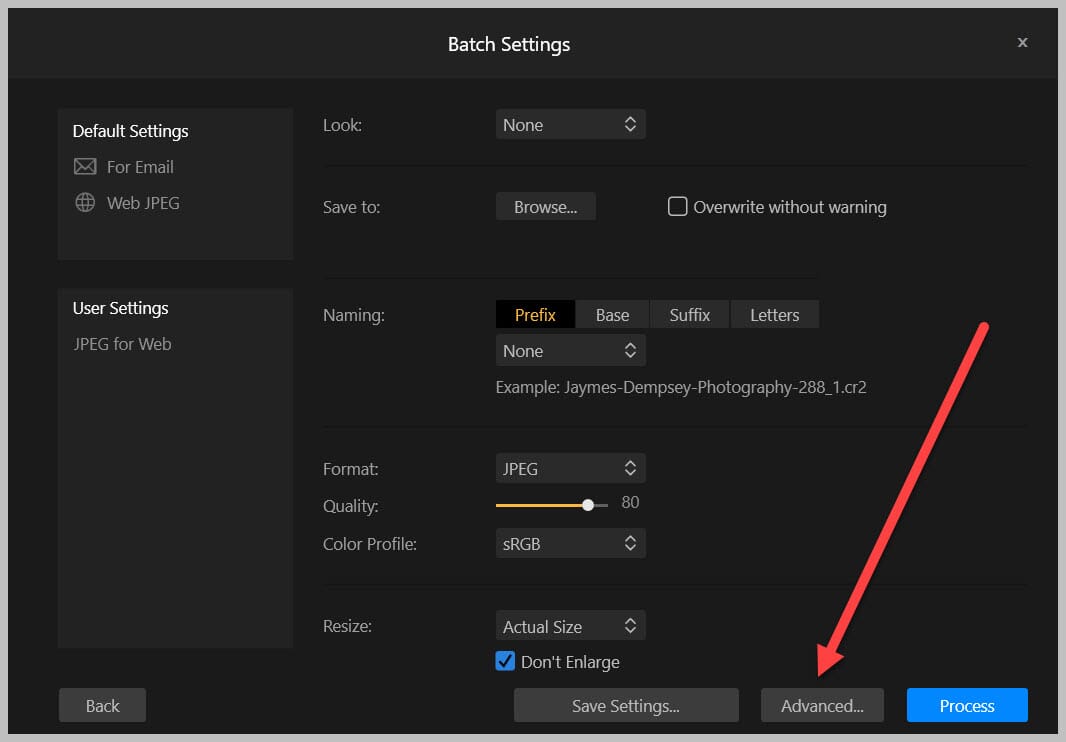
And choose a sharpening level:
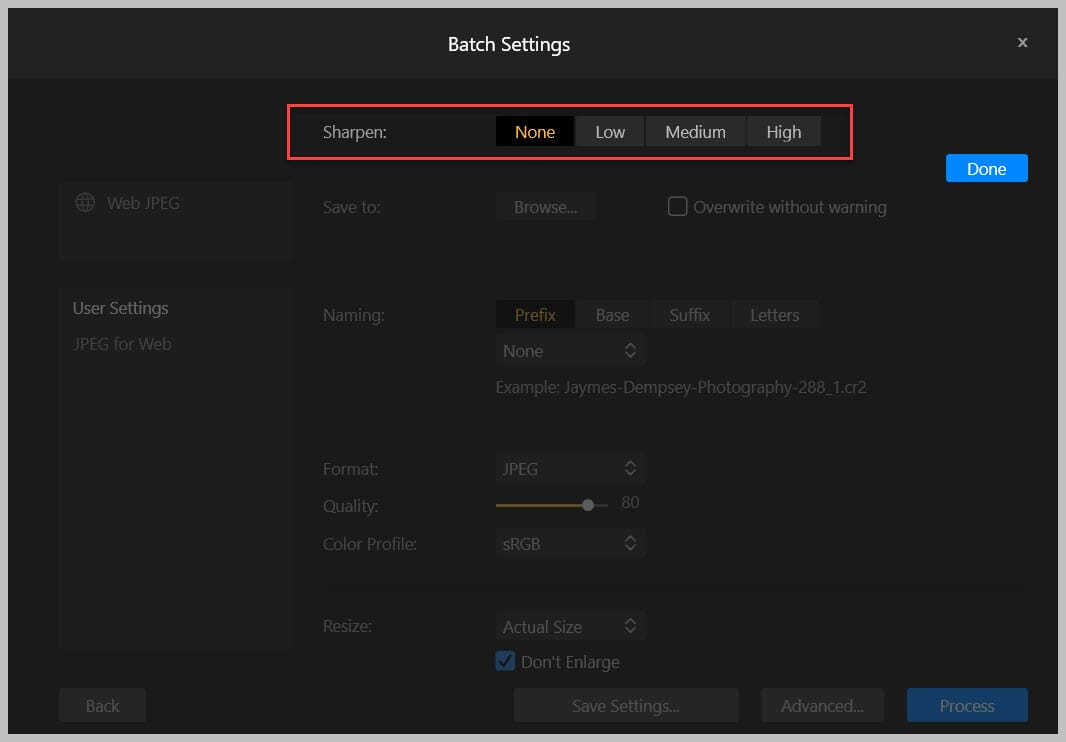
Finally, tap Process.
How to Convert RAW to JPEG with Luminar AI
Converting images from RAW to JPEG in Luminar AI is quick. Just open your image and select Export:
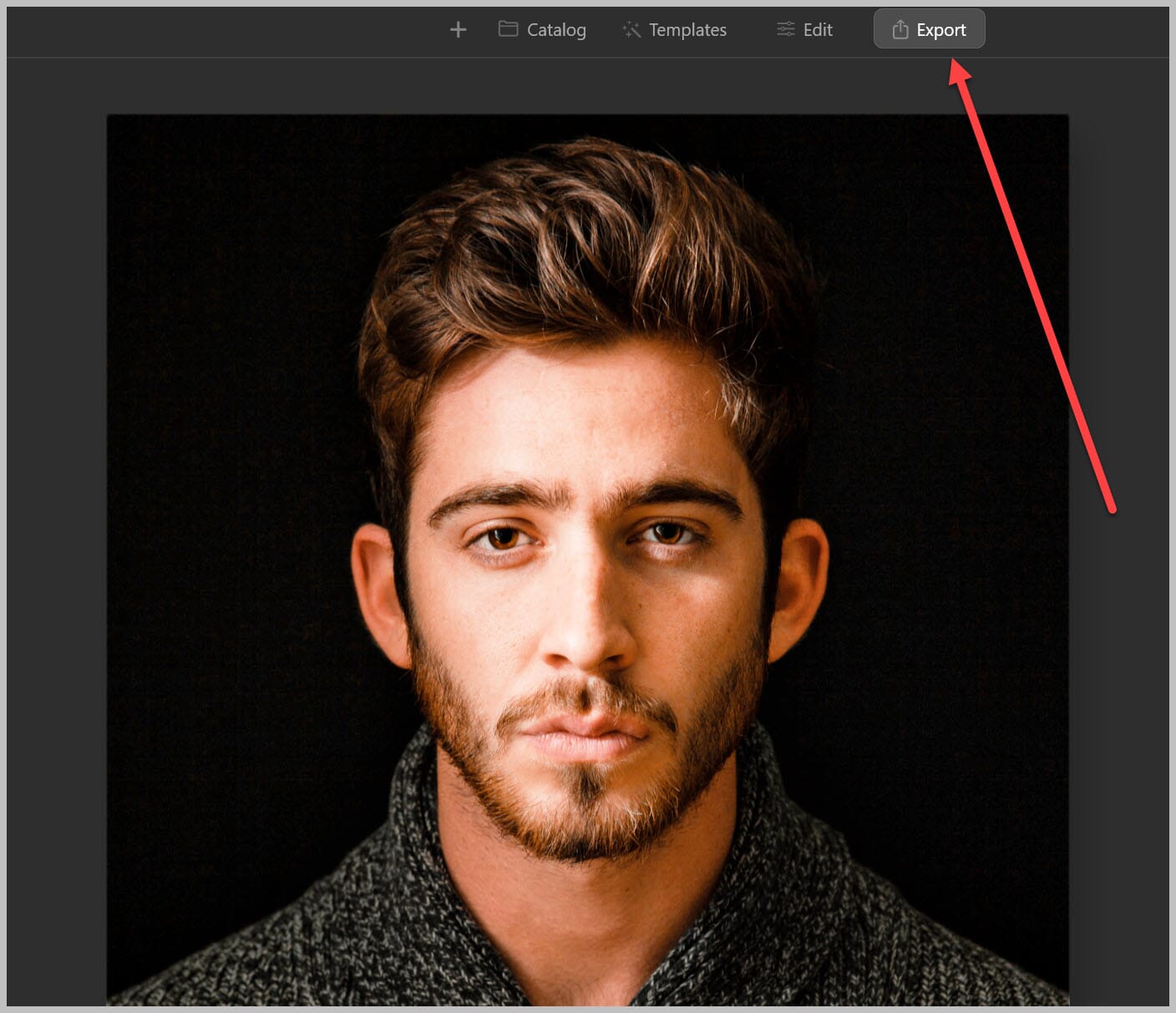
Then tap Save Photo to Disk:
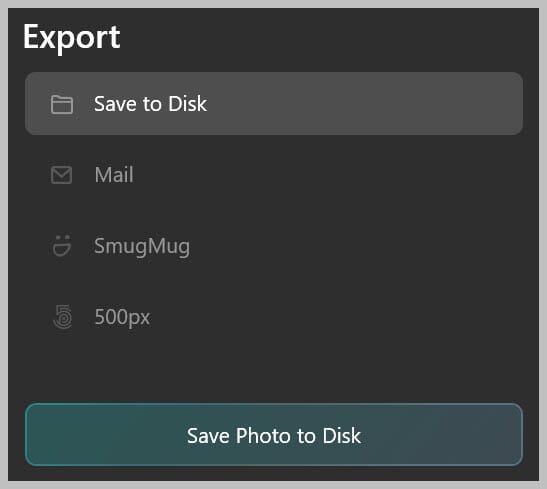
Pick a Location, a File Name, and adjust the Format to JPEG:
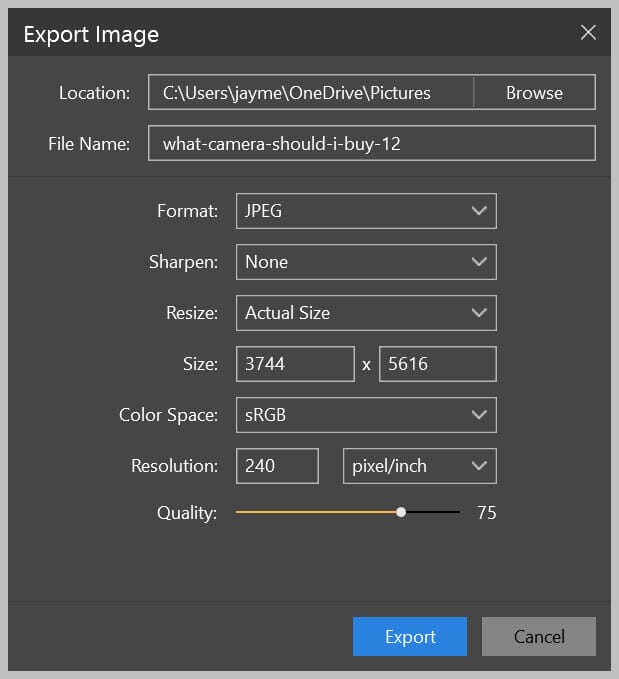
Go ahead and add a bit of sharpening for web display (I recommend the Low option).
Feel free to Resize and/or change the Quality if you have specific file size needs.
And then tap Export.
Unfortunately, Luminar AI offers no batch-conversion options, so if your goal is to convert many RAW photos to JPEG, you’ll want to consider a different option, such as Lightroom, Luminar 4, or even one of the online methods I discussed above.
How to Convert RAW to JPEG with Photoshop
Photoshop is an ultra-powerful program – so, as you might expect, it actually offers several ways of converting RAWs to JPEGs (with various levels of control and involvement).
The simplest method – and the one I use most often – is to open your photo, then select File>Save As:
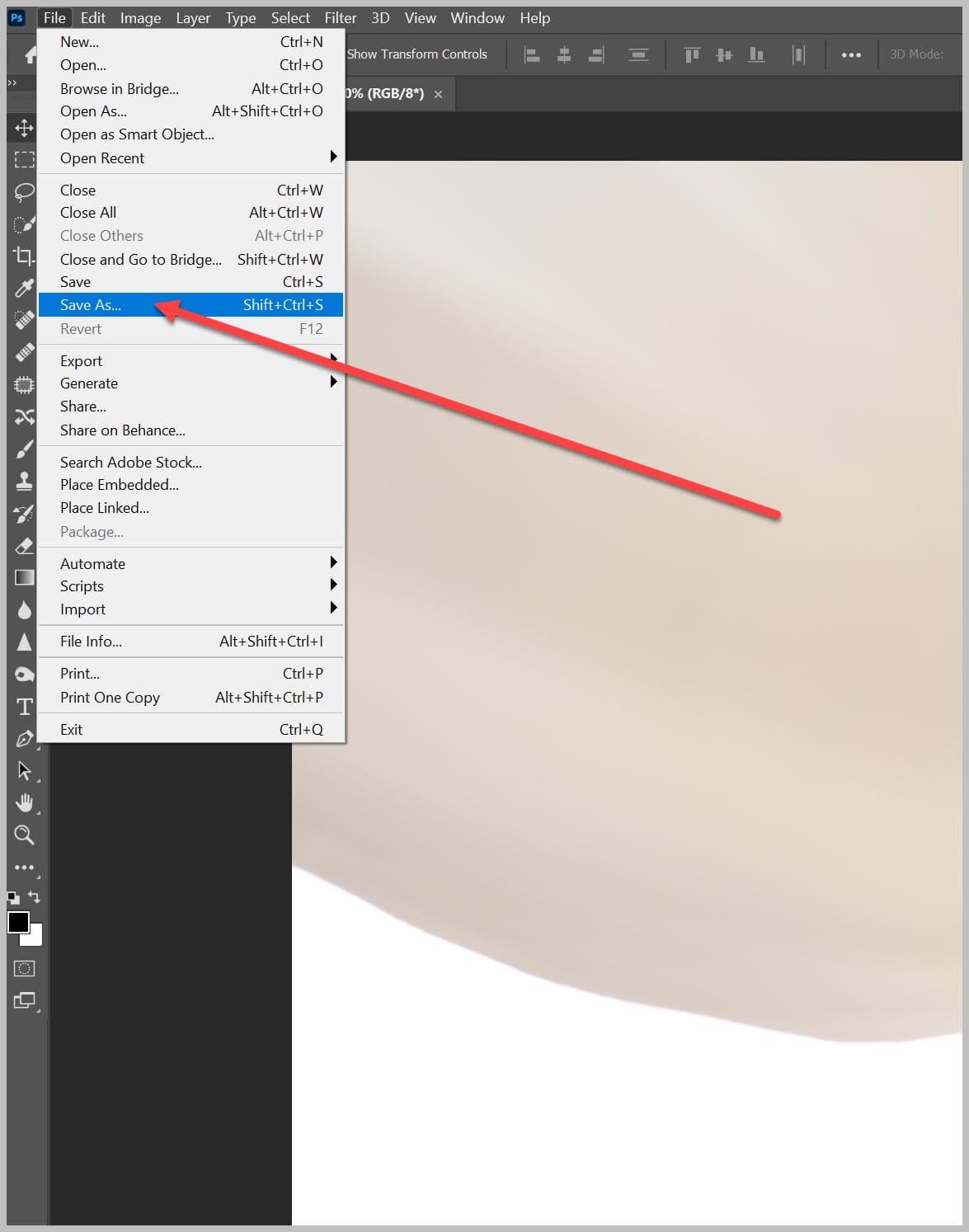
Rename your file, select your preferred location, and change the Save as type to JPEG:
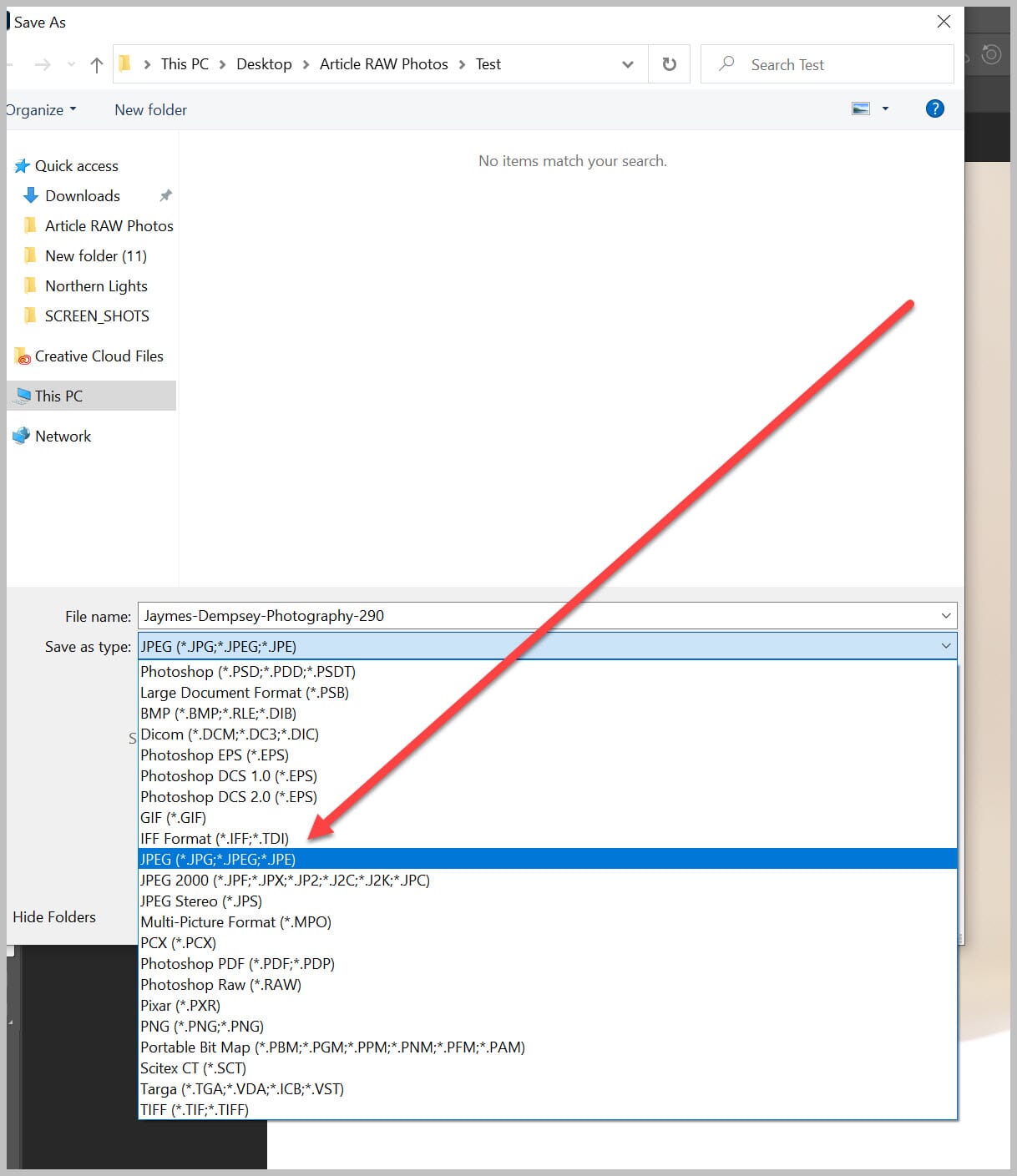
Hit Save, and you’ll see the JPEG Options dialog box:
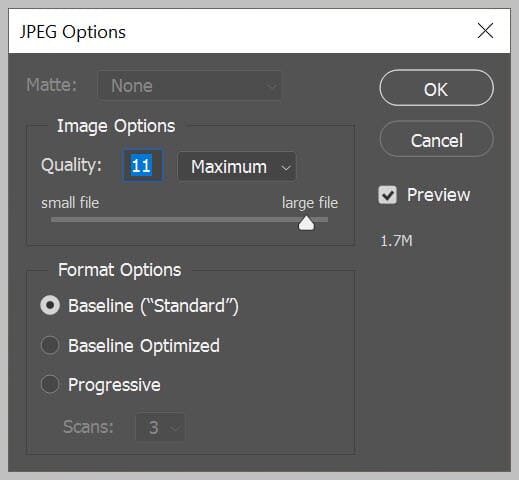
Here, you can select the image quality (I recommend leaving the Format Options to the default), then hit OK.
But if you want more control and resizing options, another Photoshop RAW-to-JPEG conversion method is via the File>Export As path:

Then select JPG under File Settings>Format:
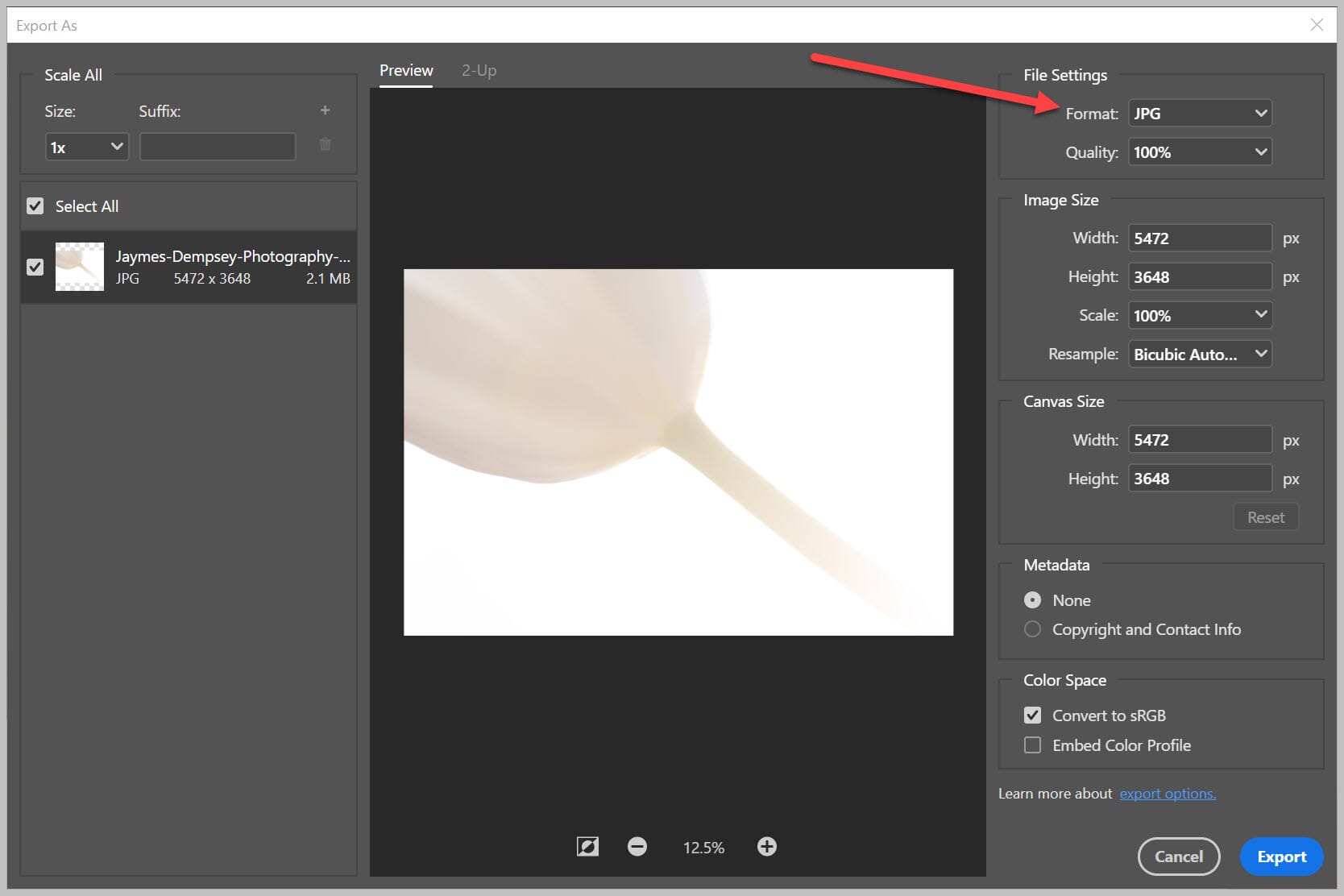
You can adjust the image size, as well as the canvas size – and you can even see a preview of your image before exporting.
Once you’re done making adjustments, tap Export, then pick your download location:
Easy, right?
Converting RAW to JPEG: Final Words
Well, there you have it:
Several easy methods to convert from RAW to JPEG – using Preview on a Mac, using Pixillion on a PC, using online converters, and using Lightroom, Photoshop, and Luminar.
In other words:
If you’ve read to the end, you should definitely know a few good ways to convert your RAWs to JPEGs (and to pretty much any other file format you can imagine!).
So go do your conversion.
And then spend some time admiring your newly-minted JPEGs!
How do I convert RAW to JPEG?
That depends on your operating system and your preferred programs. But if you use a Mac, you can easily convert with Preview (just open in Preview, then hit Fileu003eExport and select JPEG ). On a Windows PC, you can download Pixillion, which offers a quick (and free) method of RAW conversion. You can also convert to JPEG using an online converter, such as CloudConvert, or you can easily use a program such as Lightroom Classic, Luminar 4/AI, or Photoshop.
How do I convert a file to JPEG on a Mac?
On a Mac, the quickest way to convert is with Preview; you open your image, select Fileu003eExport , and pick JPEG . If you want to edit before converting to JPEG, a better option is to use Lightroom, Photoshop, or Luminar, all of which have their own RAW-to-JPEG conversion processes (as I describe in the article).
What is the fastest way to convert RAW to JPEG?
On a Mac, the program Preview is pretty darn fast. Pixillion is a fast program for Windows PCs. If you need to convert many images at high speed, then I highly recommend Lightroom Classic, which can handle literally hundreds of RAW conversions in very little time.
How do I convert multiple images to JPEG on Mac?
Preview lets you do batch conversions; just select all the RAW files, then right-click, pick Open Withu003ePreview . Next, make sure all the images stay selected, and pick Fileu003eExport Selected Images . Pick Options , then select the JPEG format.
Does converting RAW to JPEG lose quality?
Yes, converting an image from RAW to JPEG is always going to involve some loss of quality because a JPEG, by definition, is compressed.
